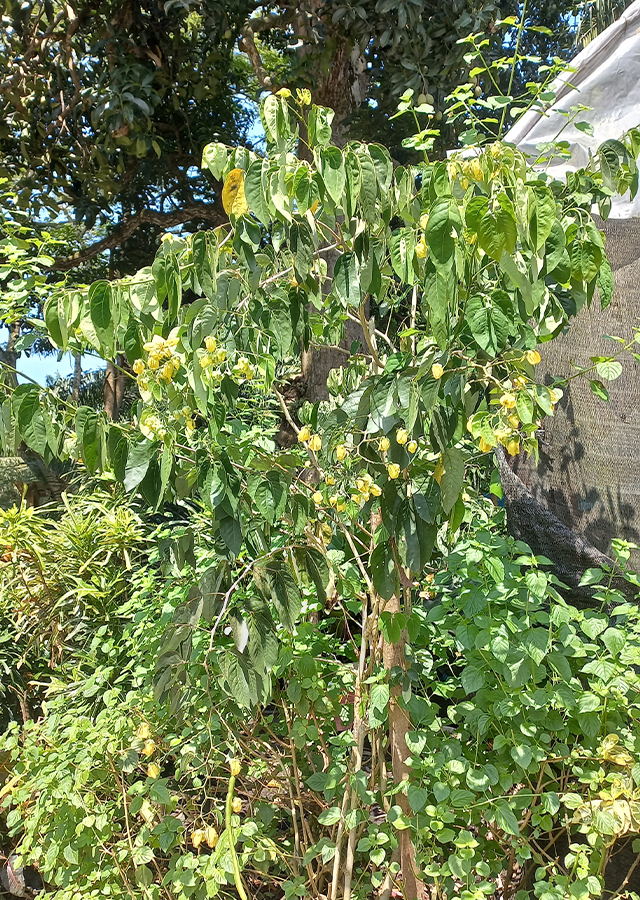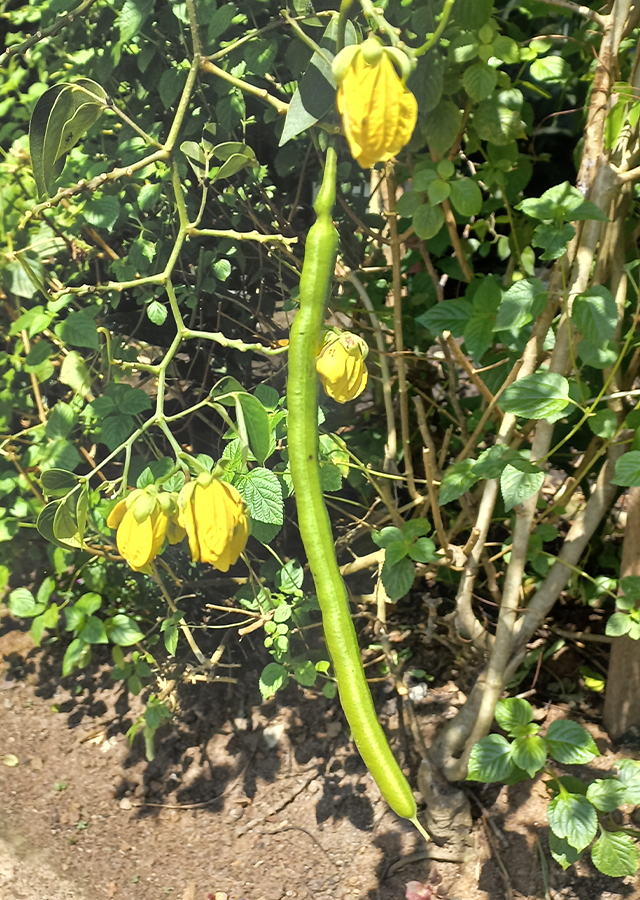Large-Flowered Cassia
Senna macranthera (DC. ex Collad.) H.S.Irwin & Barneby
Fabaceae
Location in our garden
Principal



Synonym
Cassia macranthera DC. ex Collad.
Habitus
Trees. A fast growing, deciduous or semideciduous perennial tree with a dense, roundish crown that can grow 6-8 m tall.
Part Used
Leaves
Bark
Growing Requirements
Full Sunshine
Habitat
Riverbanks
Forest
Overview
Senna macranthera is native to South tropical America (Bolivia, Brazil, Colombia, Ecuador, Paraguay, Peru, Venezuela), and cultivated elsewhere. The tree is sometimes harvested from the wild for local use as a medicine, food and source of wood. A useful pioneer species, it is an ornamental plant when in bloom that can be used in landscaping and is suitable for planting under power lines along streets. A pioneer species that can be used in planting schemes for establishing woodland. The wood is light in weight, soft and of poor durability when exposed to the elements. The wood is used for fuel. The plant is classified as 'Least Concern' in the IUCN Red List of Threatened Species (2011).
Vernacular Names
Manduirana (Brazil).
Agroecology
Can be found in highland semideciduous forests, usually in more open, secondary formations and only occasionally in the dense primary forest, and also in savannah. Grows best in a sunny position. Succeeds in a wide range of soils.
Morphology
- Stem - trunk 6-15 cm in diameter, the wood is light in weight, soft and of poor durability when exposed to the elements.
- Leaves - below inflorescence are 2-26 cm. Distal pair of leaflets are obliquely lanceshaped-elliptic to ovate or obovate, varying from short-tapering blunt to triangularly pointed 1.8-16 x .8-6 cm, about 1.8-3.5 times as long as wide, with asymmetric base which is heart-shaped or rounded or broadly wedge-shaped, with a midrib with 6-12 pairs of veins.
- Flower - usually borne in panicles. Flower-cluster-stalks, together with raceme axis, are 2-7.5 cm, the latter 3-14-flowered; bracts lanceshaped, triangular, lanceshaped-ovate, or elliptic-inverted-lanceshaped 1.3-4 mm, falling off early. Buds are spherical, finely velvet-hairy, sepals either firm or somewhat membranous, often yellowish or pallid or pallid-edged, strongly graduated, in outline broadly obovate to nearly round to elliptic-inverted-lanceshaped, the largest of the inner ones 4-14.5 x 1.8-8 mm. Petals are finely velvet-hairy dorsally especially along veins, homomorphic except for the often slightly wider upper one and for one lower slightly more oblique, all contracted into a slender claw 2-4 mm, the blades varying from broadly obovate to oblong-inverted-lanceshaped, all blunt, the longest 2.5-4.5(-5) cm. Stamens are of varying length, up to 9 mm, anthers 4-10 mm, style 1.5-5 mm, little dilated at tip.
- Fruit - pod are drooping or (when short) irregularly spreading, the beak 4-9 mm, the nearly cylindroid body straight or sinous 6-26 x 0.6-1.4 cm.
- Seed - obovid, brown, hard, 5-7 x 3,5- 5 mm.
Cultivation
- Generatively propagated by seed - it has a hard seedcoat and may benefit from scarification before sowing to speed up germination. This can usually be done by pouring a small amount of nearly boiling water on the seeds (being careful not to cook them!) and then soaking them for 12-24 hours in warm water. By this time they should have imbibed moisture and swollen - if they have not, then carefully make a nick in the seedcoat (being careful not to damage the embryo) and soak for a further 12 hours before sowing. Sow the seed in a partially shaded position in a nursery seedbed.
- A moderate germination rate can usually be expected, with the seed sprouting within 10-30 days. When the seedlings are 4-6 cm tall, pot them up into individual containers and they should be ready to plant out 4-5 months later
Chemical Constituents
Phenolic compunds (flavonoids, tannins and coumarin), anthraquinone emodine.
Traditional Medicinal Uses
- In India, it is used in the treatment of syphilis.
- Studies have shown anti-inflammatory, antioxidant, intestinal motility and laxative activities.
Part Used
Reference Sources
- Alamy. (2022). Manduirana. https://www.alamy.com/manduirana-senna-macranthera-campina-do-monte-alegre-so-paulo-brazil-image346992918.html. 21-05-2022.
- Fern, Ken. (2021). Useful Tropical Plants: Senna macranthera. http://tropical.theferns.info/viewtropical.php?id=Senna+macranthera. 21-05-2022.
- Flora of India. (No date). Large-Flowered Cassia. https://www.flowersofindia.net/catalog/slides/Large-Flowered%20Cassia.html. 21-05-2022.
- Guarize, L., and Carvalho da Costa, J. (2011). Anti-inflammatory, laxative and intestinal motility effects of Senna macranthera leaves. Natural Product Research, 26(4): 331-43. DOI:10.1080/14786411003754264. Also available: https://www.researchgate.net/publication/50834010_Anti-inflammatory_laxative_and_intestinal_motility_effects_of_Senna_macranthera_leaves.
- Kew Royal Botanic Gardens. (No date). Plants of the World Online: Senna macranthera. https://powo.science.kew.org/taxon/urn:lsid:ipni.org:names:911359-1. 21-05-2022.

